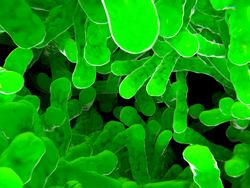Biological chemistry reveals evolution and environmental adaptation of microorganisms
The aim of the BAGEL (Bacterial formation of glycerol (di)ether lipids: biogeochemical, (paleo)environmental and evolutionary implications) project was to investigate the first isolates of marine mesophilic sulfate-reducing bacteria (SRBs) capable of producing DGDs. These lipids combine the structural characteristics of bacteria and archaea and have mostly been found in extremophilic bacteria, although they are widespread in non-extreme environments and ancient ecosystems. Even though the reason ether lipid biosynthesis has evolved in bacteria is currently unknown, their presence in mesophilic bacteria may help to explain the evolution of cellular life and the divergence of archaea and bacteria. A combination of organic geochemistry (analysis of lipid biomarkers) with microbial ecology (bacterial ecophysiology based on ultrastructure) techniques was applied to two strains of mesophilic SRBs in relation to different environmental parameters. Project partners studied the production of DGDs, especially with regard to salinity and the limitation of phosphorus and nitrate nutrients. The effect of oxygen on the long-term stability of alkylglycerol lipids and cell ultrastructure of DGD-forming bacteria was also explored. Results showed that different nutrient and salinity stressing conditions induced variable responses in cell ultrastructure and lipid content. Most important changes were observed under low salinity and nitrogen concentrations, under which mono- and dialkylglycerols (MGM and DGD) seem to play a similar role to classical fatty acids in membrane adaptation. A study of the influence of the growth substrate on the alkylglycerol composition of the two strains, revealed the unprecedented accumulation of wax esters (WE) in cells grown on n-alkyl compounds. In addition to WE, thiowax esters (TWE) were also identified among cellular lipids of both strains. Such biological production of organic sulfur compounds (TWEs) under natural anoxic conditions is unprecedented. This suggests that the ability to produce WEs and TWEs is a characteristic of specific mesophilic SRBs. BAGEL, therefore, provides a new approach into the biocatalytic potential of WEs and TWEs. It also gives fresh insights into crucial aspects of microbial ecology and the evolution of lipid biosynthesis in prokaryotes.







